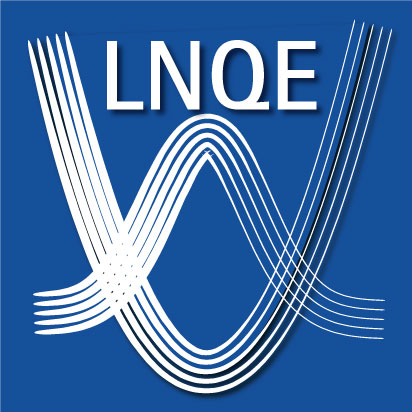Complex nanoswitches in bosonic computers for digital transformation
| Leitung: | Supervisor: Prof. Dr. Franz Renz, LUH, Institute of Inorganic Chemistry. Co-Supervisors: Prof. Dr.-Ing. Ralf Franz Sindelar, Hochschule Hannover & apl. Prof. Dr. Dirk Dorfs LUH, Institute of Physical Chemistry and Electrochemistry |
| Team: | Kevin Tran |
| Jahr: | 2020 |
Within this project coordination chemistry based molecular switches will be utilized to create novel bosonic building blocks, e.g. light operated transistors for future bosonic quantum computers. As substrates for such switchable molecules a variety of links between environments are used. Among them, onedimensional fibers (e.g. graphene containing) are provided by the group of Ralf Sindelar (see their project) and nanoscopic particles are provided by the group of Dirk Dorfs.
We selected building blocks based on transition metal complexes, which are switchable between low spin and high spin states. The switching is reversible and triggered by external stimuli like temperature, light, pressure and application of external electric or magnetic fields. While switching the spin state some significant properties change, such as electrical conductivity, color, refractive index, magnetism and polarization of light. In a first approach known and suitable complexes will be modified and analyzed subsequently. In this context, the relationship between structure and switching properties is crucial. A major advantage of such complex compounds is the tuneability of switching properties by chemical modification of utilized organic ligands. This derivatization changes the inductive and mesomeric electronic and steric properties. Furthermore, the metallic central units can be varied in their oxidation state and coordination environment. Additionally, their optical properties can be tuned by chirality. In a second step, simple components of future devices, e.g. bosonic transistors operated by light instead of electricity, will be created; followed by miniaturization on nanoparticles towards a bosonic single molecular transistor. Replacing electrons by photons enables new generations of significantly faster and more efficient quantum computers, such as the transition from copper cables to glass fiber technology.
The three projects of Sindelar, Dorfs and Renz collaborate.
Within this project coordination chemistry based molecular switches will be utilized to create novel bosonic building blocks, e.g. light operated transistors for future bosonic quantum computers. As substrates for such switchable molecules a variety of links between environments are used. Among them, onedimensional fibers (e.g. graphene containing) are provided by the group of Ralf Sindelar (see their project) and nanoscopic particles are provided by the group of Dirk Dorfs.
We selected building blocks based on transition metal complexes, which are switchable between low spin and high spin states. The switching is reversible and triggered by external stimuli like temperature, light, pressure and application of external electric or magnetic fields. While switching the spin state some significant properties change, such as electrical conductivity, color, refractive index, magnetism and polarization of light. In a first approach known and suitable complexes will be modified and analyzed subsequently. In this context, the relationship between structure and switching properties is crucial. A major advantage of such complex compounds is the tuneability of switching properties by chemical modification of utilized organic ligands. This derivatization changes the inductive and mesomeric electronic and steric properties. Furthermore, the metallic central units can be varied in their oxidation state and coordination environment. Additionally, their optical properties can be tuned by chirality. In a second step, simple components of future devices, e.g. bosonic transistors operated by light instead of electricity, will be created; followed by miniaturization on nanoparticles towards a bosonic single molecular transistor. Replacing electrons by photons enables new generations of significantly faster and more efficient quantum computers, such as the transition from copper cables to glass fiber technology.
The three projects of Sindelar, Dorfs and Renz collaborate.






